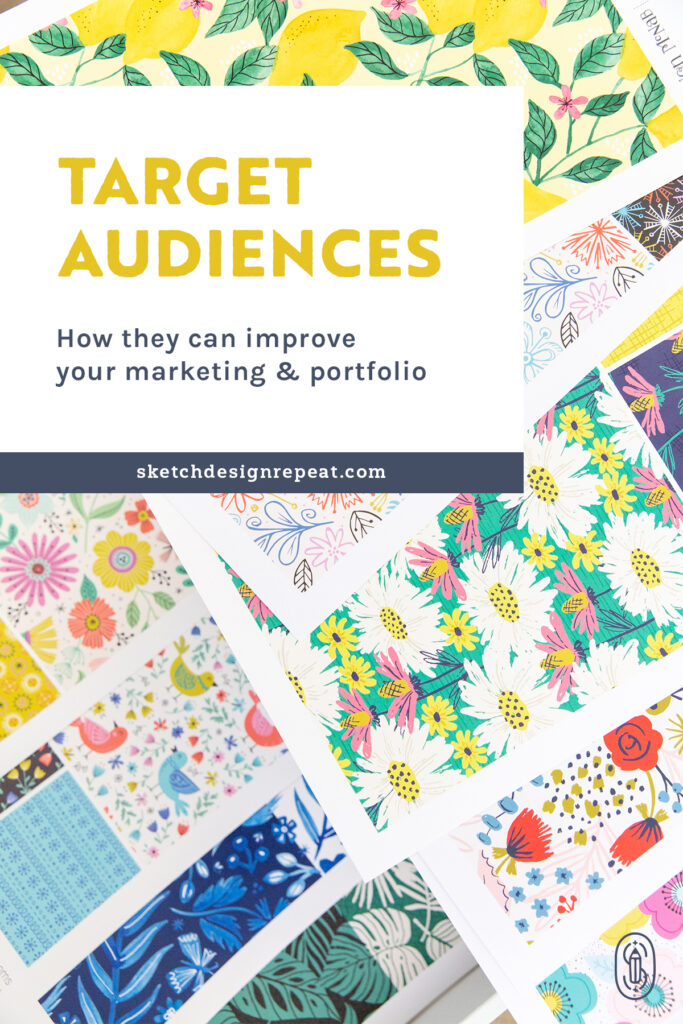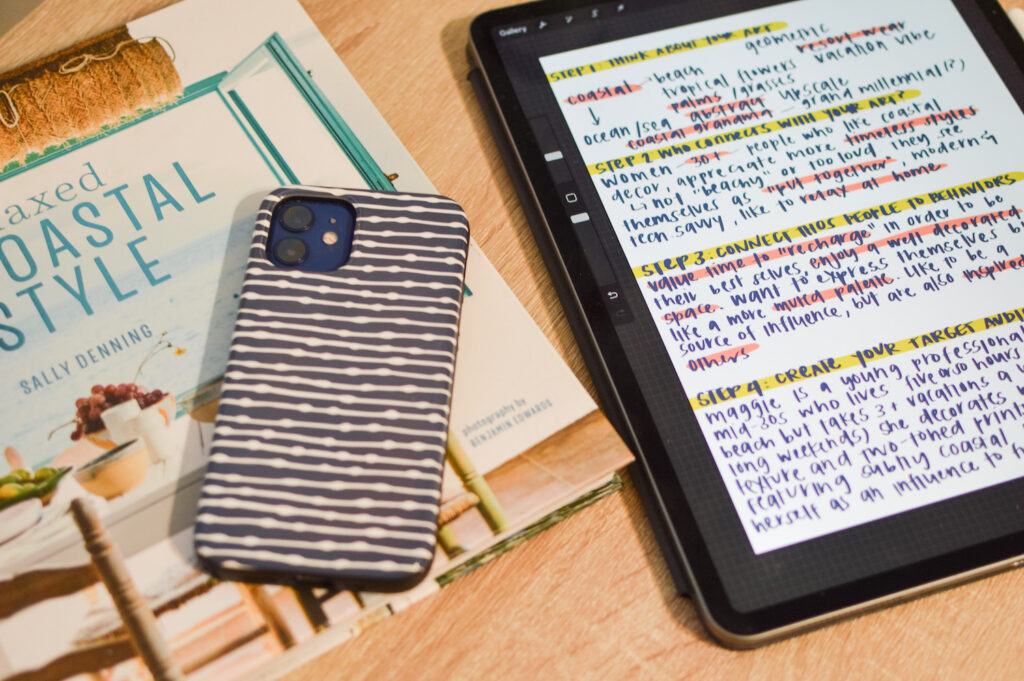“If you’re talking to everyone, you’re connecting with no one.” This phrase (often attributed to Seth Godin) can be found in the marketing corner of the internet that loves to talk about “niching down,” and is a bit daunting for creatives who want to reach as many people as possible with their art. But what if I told you that you’ve got a better shot at growing your business by only talking to a small community of people?
Focusing on a connection to a specific community can help you to use social media content marketing to grow your brand and strengthen your portfolio. Because once you’ve engaged with a community that rallies around you, they’ll share their connections and will support everything you do!
The specific community you most want to connect with, in marketing speak, is your target audience. A target audience is a group of people defined by certain demographics and behaviors that is interested in buying a product or service. More casually, it’s your people — the people who buy what you’re selling, share it with others, and engage with you online. Not every person who buys your art will fit into a box but finding similarities between the majority of your audience is the most effective way to talk about what you’re offering.

While demographics like age and location can be important, for most online based businesses, understanding behaviors of people interested in your art can be much more meaningful.
Identifying your target audience as a licensing artist can be tricky… technically, you have two: Art buyers, and the people who buy the product featuring your art. As an artist you get paid when you license a piece to a client, but because your client is buying with their own target consumer in mind, it’s important to think about what many in the marketing industry call the “end consumer.”
The people buying your art on door mats or mugs are ultimately the people you’re creating for and defining that can help you better identify and pitch to art buyers. But more on that later. First, you need to define the community of consumers buying your art on products.

To get started, grab a large piece of paper or a fresh canvas in Procreate and get ready to write some things down. There are four steps, but you can organize them horizontally, vertically, or as a square… you’re the boss. Ideally, you’ll have plenty of space to jot down ideas in a way that you can see everything on one page, while giving yourself space for lots of thoughts or to go back and make changes. I’d challenge you to write a minimum of 10 ideas each for Steps 1 and 2, and as many as 20 for Step 3.
Writer’s note: I’m going to give a few examples of how I worked through my personal brand, but I’ve intentionally shared only a summary of each exercise as to avoid influencing your own brainstorming.
How to Identify Your Target Audience
For many surface pattern designers and creatives, your target audience often feels like your own personality and demographic. While that’s not wrong, walking through these exercises may help you realize some nuances and behaviors beyond your own experience or stage of life.
Step 1: Think about your art
Take a few minutes to scroll through your portfolio (or art files) and think about your work. How would you describe your style? What feelings does it evoke? What motifs or themes stand out (and which themes and motifs do you enjoy creating most)? List adjectives and synonyms, motifs, and themes that fit with your work and style. Don’t worry about complete sentences here (in fact, avoiding complete thoughts will help you keep your mind open).
For CoastL Studio: Inspired by coastal flora, the beach, semi-abstract motifs, limited color palette.
Step 2: Who connects with your art?
Refer to your art as you described it in Step 1. What kinds of people might connect with your art? Who would put this in their home or closet? Where do they live? Where do they go — for shopping? For travel? For fun? What is their perception of themselves and the world around them? These can be as broad or specific as you’d like (and they don’t all have to go together — this is a great place to get all the ideas out).
For CoastL Studio: Women — mostly, like the beach (but may not live there), consider themselves stylish but not always trendy, like modern décor, enjoy decorating
Step 3: Connect those people to behaviors
What do the people you’ve described in Step 2 do with their time? What types of products do they buy? What other things do they need? What sorts of activities or hobbies do they participate in? What sources of influence do they have? What sorts of problems are they looking to solve? What do they read or interact with online? What do they value?
For CoastL Studio: Women who want to feel like they’re on vacation every day, who are looking for upscale but comfortable products that may not be as bold as traditionally beachy décor. They value individuality but look up to others for inspiration.
Step 4: Create your audience
From your notes for Step 3, identify 5–7 behaviors that most represent how you see the people you’re creating your art for, or who would like to buy your art on products. Give that person a name, maybe an age range, and turn their behaviors into a short bio. This avatar can be a simple way to keep your target audience in mind.
For CoastL Studio: Maggie is a young professional in her mid-30s who lives a few hours from the beach but visits one 2–3 times per year. She decorates her home with some subtle coastal patterns and abstract art but avoids busier patterns and bright colors. She shops at Serena & Lily, Madewell, and Pottery Barn. She enjoys hosting friends for happy hour and dinner parties and puts effort into entertaining but likes it to appear casual and breezy.

Now you have your target audience, let’s talk to them!
I’ve heard from several artists that they’re not always sure what to write in Instagram captions, or what to post on a blog when they’re sharing new work, mock-ups, or behind the scenes of their process. As a very visual industry, it can be easy to rely on pretty pictures and prints, but to engage with your current audience and gain new followers, you need to create a connection with those beautiful art pieces.
Related Article: Marketing Art: 3 Tips for Introverts
One of the core principles of content marketing is building a relationship with your target audience by connecting what you’re selling to their needs. Using content marketing as a tactic can help you step into the world of sharing and self-promotion without feeling pushy or salesy (which is still an important part of marketing). People who resonate with your art and connect with your style want to see how your offering (your art in any form) can make their lives better — from having a well styled home to just a little burst of joy — and seeing that can help convert them to a loyal customer!
Looking at the behaviors that your audience participates in can help you find ways that your art fits into their lives. To continue my CoastL Studio example, my audience may not live near the beach, but still loves it — so I work to make sure what I share on social media (and in blog posts) shows how I can help them “add a little vacation into every day.” If your target audience is athletic, maybe you share your patterns as a background to a relevant motivational quote or sporting event. Or share your work mocked up with a product that is relevant to them and suggest that it would be so fun to see it in real life.
Growing an online community can help you catch the eye of possible companies for licensing, collaborations, or can help you stand out while pitching as a great potential partner! Speaking of pitching…

How to use your understanding of your target audience avatar to improve your portfolio and pitching
As Shannon advises in her post about two things your surface design portfolio should have: “instead of trying to be all things to all companies, get clear on the type of products you want to see your art on and focus your attention on building a portfolio to match.”
Knowing what audience fits your style, motifs, and product categories can help you choose which pieces to prioritize in your portfolio, and what gaps you may want to fill. As you’re thinking about what types of products your audience would buy, think about the art they’d like to see on them, and use that as a guide to add pieces to your portfolio.
As part of the exercise of identifying your audience avatar, I mentioned asking yourself where your people might shop. Congrats, you’ve started a new pitch list! Using these companies as a starting point, you can begin to look for dozens of other companies that may also be targeting the same audience. As an example, my target audience may shop at Serena & Lily, so I may want to start looking at smaller companies with a similar aesthetic. (Finding companies is a whole other topic — one Shannon covers in Pitch Your Portfolio.)
After you’ve found contacts at companies, you can incorporate your target audience knowledge into your outreach, showing that you understand both your own style, and the business of selling products. This can help you stand out (on top of your engaged online community) to art buyers and create a connection from your first email.
Hopefully, now you’re feeling confident in your understanding of what a target audience is and how to identify it. Most importantly, you now have some concrete ways to use your target audience to create content, reach out to new companies, and stand out to art buyers who are looking to license art to your target audience.
Interested in taking your content marketing to the next level? My course Surface Design Marketing: Creating Content to Grow Your Business will help you build out a content strategy that makes coming up with ways to connect to your audience easier and more effective!

Written by Leah Keggi
Website: www.LeahKeggi.com
Instagram: @coastlstudio
Class: Surface Design Marketing: Creating Content to Grow Your Business
Leah Keggi is a Marketing Pro and Pattern Designer looking to bring a little vacation into every day with coastal inspired design! Her work has been featured on Today.com and on products at Target.com. When she’s not designing (or working in Marketing) you can find her reading, enjoying her husband’s cooking, or walking her pup!
I’ve never considered this before. I was stuck on thinking about how to market myself to art directors rather than the end consumer. Thank you!